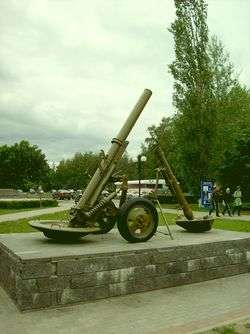160mm Mortar M1943
| 160 mm mortar M1943 | |
|---|---|
 | |
| Type | Mortar |
| Place of origin | Soviet Union |
| Service history | |
| Wars | |
| Specifications | |
| Weight | combat: 1,170 kg (2,580 lb) |
| Barrel length | 3.03 m (9 ft 11 in) |
|
| |
| Shell | 40.8 kg (90 lb) bomb |
| Caliber | 160 mm (6.29 in) |
| Elevation | +45° to +80° |
| Traverse | 25° |
| Rate of fire | 10 rounds/minute |
| Muzzle velocity | 245 m/s (804 ft/s) |
| Effective firing range | 5,150 m (5,630 yd) |
The Soviet 160 mm Mortar M1943 was a smoothbore breech loading heavy mortar which fired a 160 mm bomb. The M1943 (also called the MT-13) was one of the heaviest mortar used by Soviet troops in World War II. Around 535 of these weapons were fielded with Soviet forces during the war. It was replaced in Soviet service after World War II by the M-160 mortar of the same caliber.
Description
Originally a simple scaling-up of the 120 mm M1938 mortar, it soon became apparent that drop-loading a 40 kg bomb into a 3 meter high tube would be too difficult for any man to do. It was redesigned into a breech loading weapon, and contains a substantial recoil system to soak up the massive shock of firing a 160 mm bomb and prevent the baseplate from burying itself too deeply.
The barrel sits in a cradle which is attached to a baseplate and tripod. To load the weapon, the barrel is hinged forward which exposes the rear end of the tube. The bomb is then loaded, retained in place by a catch, and the barrel is swung back into the cradle, which in effect closes the breech.
Because of the weight of the mortar, it is equipped with wheels and is designed to be towed by a motor-driven vehicle.
Tactical organization
The Soviet Army deployed the 160-mm mortar in brigades of 32 mortars each. The brigades were composed of four battalions of eight mortars each. Such brigades were part of the artillery divisions formed from 1944 onward (see Divisions of the Soviet Union 1917-1945).
Postwar service
Used postwar by
 Albania[1]
Albania[1] Bulgaria
Bulgaria Czechoslovakia
Czechoslovakia Egypt
Egypt Georgia Produced locally by Scientific Technical Centre Delta since 2011.
Georgia Produced locally by Scientific Technical Centre Delta since 2011. Mali - Armed and Security Forces of Mali
Mali - Armed and Security Forces of Mali Mongolia
Mongolia Poland
Poland Romania
Romania Syria
Syria Vietnam
Vietnam
References
- Hogg, Ian (2000). Twentieth-Century Artillery. Friedman/Fairfax Publishers. ISBN 1-58663-299-X
- Hogg, Ian (editor) (1984). Jane's Infantry Weapons. Janes Publishing Limited. ISBN 0-7106-0796-2.
- Zaloga, Stephen and Ness, Leland. Red Army Handbook 1939-1945. Sutton Publishing. ISBN 0-7509-1740-7.
External links
| Wikimedia Commons has media related to 160 mm mortar M1943. |